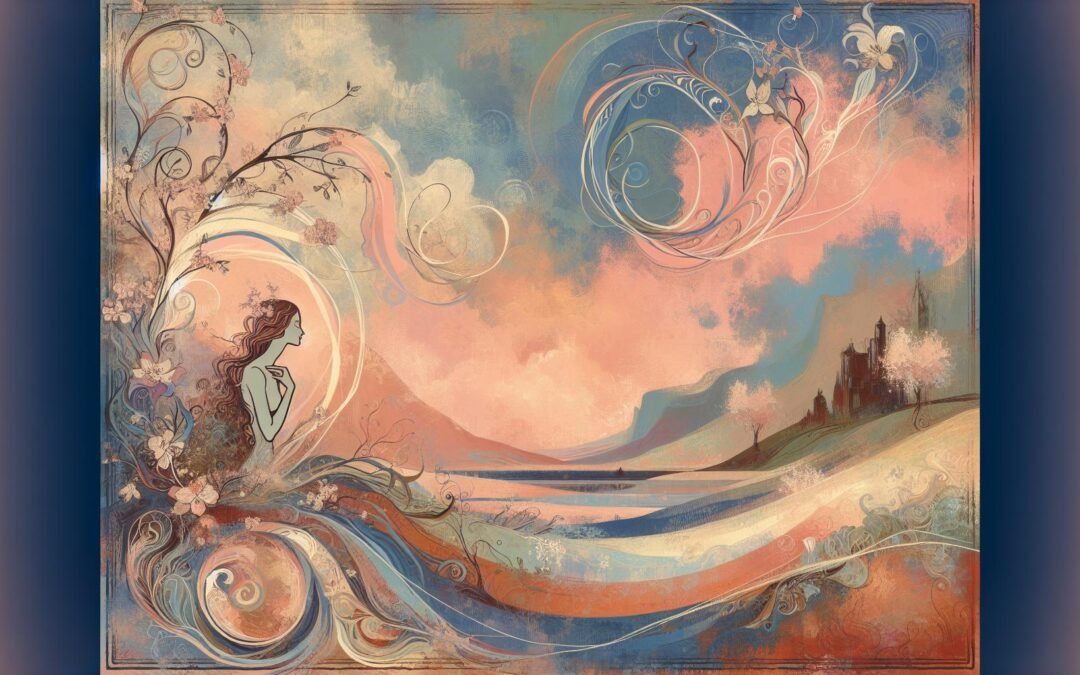Deep love poems for her from the heart have shaped literary history across centuries, threading artful expression, personal testimony, and cultural aspiration together in enduring conversation. From Sappho’s invocations to the contemporary lyric, the tradition reveals constant innovation in voice and intention. For readers seeking lasting works, the best love poems for her supply a field of emotional range for every stage of affection, heartbreak, or devotion.
Historical Evolution and Heartfelt Origins of Love Poems for Her from the Heart
The genesis of poetic address to the feminine beloved begins with Sappho who wrote confidences and desire into song, grounding feminine experience at the lyric’s foundation. While Sappho offered first-person intimacy and addressed other women, Anacreon and Propertius elevated longing to central dramatic experience, externally focused on an idealized woman. These early poems praised beauty and presence yet created a prototype for yearning and unfulfilled wish. The Roman legacy expanded with Catullus, who wrote of Lesbia, entangling desire and heartbreak through shifting images of love. Ovid gave his heroines in the “Heroides” letters full imaginative agency, writing in the person of women left waiting or betrayed. Instead of cataloging feminine traits, he allowed heroines to plead, argue, and assert, transforming the object of the poem into a speaker of her own longing.
Petrarch’s verse for Laura fixed the ideal of unattainable devotion; his “Her eyes are two shining stars” opened a long lineage of metaphorical transformation, echoed centuries later by the botanically charged lines of Neruda. The canzone and sonnet channeled surrender and yearning, encouraging imitators to uphold chastity and distance as poetic tenets. Troubadours brought ritualized servitude and coded worship into their beloved poems, using stylized sequences and unnerving literalness in their metaphors. By the late Middle Ages, poems turned the beloved into an emblem, sometimes reducing her to a nexus of virtues and attributes, rather than perceiving an individual.
The English Renaissance and the Sonnet
The English Renaissance marked the emergence of the sonnet as stage for psychological complexity and stylistic experimentation. Shakespeare introduced skepticism and wit as in Sonnet 130, where conventional praise twists into realism and the beloved appears as flesh and mind, not unreachable star. His lines, “My mistress’ eyes are nothing like the sun,” challenge stock metaphor with grounded honesty. Edmund Spenser and Thomas Wyatt adopted and modified Petrarchan forms, elevating narrative tension and rhetorical intensity within compact structure. Their sonnets, with their tightly managed volta, balanced idealization and corporeality while exploring the tension between adoration and reality. For further exploration of Renaissance form, see John Donne’s sonnets and lyrics, which probe spiritual union and sensual union with remarkable intricacy.
Romanticism and Expanded Subjectivity
The Romantic movement broke through conventions of restraint and performed longing in overt and passionate tones. Keats, Byron, and Shelley wrote with direct language, conjuring a singular voice that both worshipped and rebelled. Their poems use the beloved as a lens for broader existential searching, as seen in Keats’s “Bright star, would I were stedfast as thou art”. Shelley, by addressing loss and change, crafted confessions of vulnerability and desire. As Elizabeth Barrett Browning and Christina Rossetti gained recognition, the address within love poems shifted. Browning’s “Sonnets from the Portuguese” reversed roles, with female authors laying claim to voice and agency, speaking openly of longing, admiration, and autonomy. This development invited responsive poetic dialogues where love was seen as mutual, intimate recognition and not sole adoration.
Modern Expansions
Twentieth and twenty-first century poets moved beyond fixed traditions, recasting the address to reflect varying identities and new modes of intimacy. Adrienne Rich, Audre Lorde, and Ocean Vuong addressed gender, embodiment, and power through their proclamations of love. These writers dismantle passive roles and create a shared emotional field for both speaker and beloved. Themes of vulnerability, cultural inheritance, and resistance converge. In Rich’s work, love is wielded as empowerment and self-definition, particularly in poems addressed to women by women. Meanwhile, poets infuse their lines with shifting images and references, replacing the monolithic “her” with individuals drawn from memory, myth, or contemporary experience. The address refuses simple binary structure and often portrays love as evolving, complex exchange that resists neat conclusion.
Innovation in Love Poems for Her from the Heart
Innovation in heartfelt poetry depends upon the freshness and deployment of image, sound, and parallelism. Heartfelt romantic poems for her from the heart generate intimacy through original metaphors and evocative sensory detail. Poets manipulate imagery, sound, and rhythm to convey affective shifts directly to the reader.
Metaphor, Music, and Sensory Richness
Metaphor acts as the animating feature in these poems. Petrarch’s stargazing imagery influences poetic tradition in myriad guises. Neruda’s “I want to do with you what spring does with the cherry trees” reimagines touch and renewal through seasonal fertility. Shakespeare’s determination to ground the beloved subverts the ornate tradition, producing an ironic authenticity. Repetition and parallel construction reinforce emotional tone, as in E. E. Cummings’s lines: “i carry your heart with me (i carry it in my heart)”. These repetitions convert tenderness into mantra, creating an echo of intimacy that stretches across the poem.
Sound patterns such as alliteration, assonance, and consonance provide subtle musical foundation. Andrew Marvell’s famous opening, “Had we but world enough, and time” exemplifies the use of alliteration for emphasis and memory. Adroit poets play off these possibilities, introducing sound and rhythm for resonance and emotional impact. Assonance in Adrienne Rich’s “The Floating Poem, Unnumbered” softens the movement of desire, turning the line itself into an act of caress. To find contemporary examples, explore the poetry of Ada Limón, whose work infuses plant imagery and atmospheric detail with affection and longing.
Diction and Syntax
Poets choose language rich in affective power, relying on precise nouns and dynamic verbs over abstraction. The adjective “beloved” carries concentrated emotional suggestion compared to more generic terms. Syntax varies for effect, with enjambment used to draw lines of anticipation or interruption. Emily Dickinson’s “Wild nights – Wild nights!” layers exclamations and variation to mimic passionate outburst. Frank O’Hara’s catalogues in “Having a Coke with You is even more fun than…” create a conversational pace that amplifies immediacy and play. Tight, focused phrases sustain intimacy, while longer associative structures conjure connection and informality. At Emily Dickinson resources, more examples show language compressed for intensity.
Thematic Breadth and the Reframing of Intimacy
These poems traverse a spectrum from rapture to despair. Deep love poems for her from the heart work through contrast, using stark imagery and sharp turns in tone. In Ellen Bass’s “Orphans,” shrinking vocabulary as intimacy grows compresses the expanse of feeling within everyday realities. Tracy K. Smith’s “The Universe as Primal Scream” stretches emotional experience to cosmic metaphors, connecting the small with the infinite. Claudia Rankine and Jericho Brown introduce fracture and reconstruction in language, twisting the familiar vocabulary of devotion to reveal vulnerability and strength. Plant, weather, and animal imagery appear as extended metaphors in Ada Limón’s verse, grounding the experience of love in the changing natural world. These characteristics can be seen throughout the poems on poems for her collections online.
Form and Function
Form governs emotional compression and expansion. Sonnets demand clarity and ration imagery for impact; the volta introduces surprise or reversal within compact architecture. This form, mastered by Shakespeare and Barrett Browning, enables tension between revelation and concealment. Quatrains and rhymed stanzas create musical regularity, guiding the reader through rise and fall of feeling. Fixed forms encourage mnemonic recall and ritual, transforming personal emotion into shared cultural property. Modern poems frequently adopt free verse, yet still employ pattern and repetition to maintain cohesion and memory. The exploration at rhyming love poetry highlights this interplay of constraint and freedom.
Patterned language and formal devices serve as mnemonic aids for both poet and audience. Refrains, parallel syntax, and repetition at climactic moments forge musicality and imprint sentiment. The best heartfelt poems for her express personal passion and invite collective identification by appealing to recognizable forms, emotions, and situations.
The Beloved’s Identity and Transformation
Across history, “her” transforms from abstraction to presence. Sappho’s lyric gives the beloved individual dimension. Petrarch and his imitators transform her into unapproachable muse, embodying virtue and beauty. For more discussion on classical transformation, review analyses of Pablo Neruda, whose “Twenty Love Poems and a Song of Despair” refines the relationship between body and loss. As women poets claimed scenes of address, identity became dialogic, responsive, and layered with personal and political history. Empowerment within the poem emerges as both subject and tool, as seen in Lorde’s and Rich’s lines; love voiced by and for women challenges inhered power structures. Empowerment shapes tone, diction, and imagery at each point of address, moving beyond romantic stereotypes to define affection in mutual and evolving terms.
Such recasting is manifest in spiritual and platonic forms as well. Poems oriented toward friendship, kin, or self reclaim devotion from the exclusive hold of romance. Emily Brontë’s lines to her sister, or Nayyirah Waheed’s tributes to self-actualization, broaden the terrain of the beloved, rendering devotion inclusive and multiplicitous. For further reading on these broader modes, see archives of women-focused poetry or anthologies dedicated to contemporary writers.
Poetic Address, Agency, and Reader Participation
The evolution of deep love poems for her from the heart foregrounds address as a dynamic space. The beloved is no longer object alone but becomes initiator of longing, subject of agency, and at times participant in poetic creation. Dialogic poems blend imagined response with assertion, as seen in the works of poets who write both to and as their beloveds. The reader inherits interpretive freedom, participating emotionally and intellectually through engagement with layered address and innovative form. See contemporary examples catalogued at Aja Monet’s poetry resources.
Thematic Networks and Enduring Influence
Longing, devotion, and tension remain pillars across centuries. Donne, in “A Valediction: Forbidding Mourning,” embodies steadfast loyalty. Edna St. Vincent Millay, in “Love is not all,” foregrounds practical devotion over abstracted feeling. Admiration for intellect or physical presence appears with precision in many traditions and cultures, extending reach beyond fixed canon. Poets distill everyday moments into permanent emotional record, drawing readers into recognition of their own lives reflected in crafted language. For more contemporary reflections, browse modern love poem resources and review recent anthologies.
Grief, loss, and reconciliation permutations appear as counterweights to ecstatic love. Monica Youn’s “Epithalamion” and Louise Glück’s explorations of loss address sorrow with sustained metaphor, transforming absence into art. Self-love, kinship, and spiritual exchange recur, confirming the breadth of address and inclusivity of subject within deep love poems for her from the heart.

